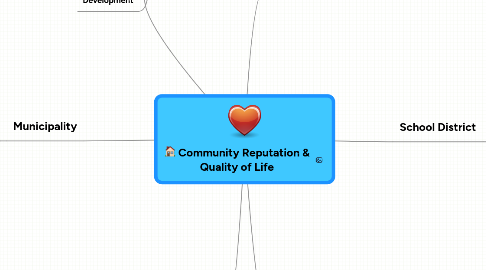
1. Municipality
1.1. Board of Comissioners
1.2. Administration
1.3. Geography
1.3.1. Location
1.3.2. Proximity to Metropolitan Areas
1.3.3. Topology/Terrain
1.3.4. Land Use Planning
1.4. Demographics
1.4.1. Educational Attainment
1.4.2. Income
1.4.3. Diversity
1.5. Economics
1.5.1. Housing
1.5.2. Commercial Development
1.5.2.1. Retail
1.5.2.2. Office
1.5.2.3. Industrial
1.5.3. Educational Institutions
1.5.4. Religious Institutions
1.5.5. Other Nonprofit Institutions
1.5.6. Revenues
1.5.6.1. Federal
1.5.6.2. State
1.5.6.3. Local
1.5.6.3.1. Commercial
1.5.6.3.2. Residential
1.5.7. Expenses
1.5.7.1. Salaries & Benefits
1.5.7.2. Construction & Maintenance
1.5.7.3. Other Services
1.6. Infrastructure
1.6.1. Municipal
1.6.2. Libraries
1.6.3. Community Services
1.6.4. Transportation
1.6.5. Security & Emergency
1.7. Communications
1.8. Other Factors
1.8.1. Environmental Responsibility
2. History
2.1. Support for Education
2.2. Support for Commercial Development
3. Big Rock Questions
3.1. What is the right balance of physical and social infrastructure?
3.2. What is the right balance of open space, commercial and residential development?
3.3. What is the right balance of services and taxes?
3.4. Do we want to be a first class community?
3.5. What are the measures for a first class community?
3.6. Are we optimizing the use of our developed land?
3.7. Are we partnering well within and around our community?
4. State Government
5. School District
5.1. Board of Directors
5.1.1. Experience
5.1.2. PSBA Standards
5.1.2.1. Advocates for a thorough and efficient system of public education
5.1.2.2. Models responsible governance and leadership
5.1.2.3. Governs through policy
5.1.2.4. Ensures that effective planning occurs
5.1.2.5. Monitors results
5.1.2.6. Communicates with and engages the community
5.1.3. Transparency
5.2. Administration
5.2.1. Experience
5.2.1.1. Core Qualifications
5.2.1.2. Leadership
5.2.1.3. Succession Planning
5.2.1.4. Continuous Learning
5.2.2. Demographics
5.2.3. Organization
5.2.3.1. Logical
5.2.3.2. Clear flow of Responsibility, Accountability, & Authority
5.2.4. Collaboration
5.2.5. Partnerships
5.2.5.1. Educational
5.2.5.2. Stakeholders
5.2.6. Culture
5.2.6.1. Vision
5.2.6.2. Core Competencies
5.2.6.3. Continuous Learning
5.2.7. Strategic Planning Process
5.2.7.1. Student-Centered
5.2.7.2. Results Oriented
5.2.7.3. Socially Responsible
5.2.7.4. Engages Stakeholders
5.2.7.5. Continuous/Frequent
5.2.8. Execution
5.2.8.1. Core Processes
5.2.8.1.1. Legal/Ethical Compliance
5.2.8.1.2. Annual Planning
5.2.8.1.3. Budgeting
5.2.8.1.4. Contracting
5.2.8.1.5. Hiring
5.2.8.1.6. Training
5.2.8.1.7. Data Collection
5.2.8.1.8. Data Analysis
5.2.8.1.9. Feedback
5.2.8.2. Risk Management
5.2.8.2.1. Recurring
5.2.8.2.2. Emergency
5.2.8.3. Performance Management
5.2.8.4. Facilities Management
5.2.8.5. Communication
5.2.8.6. Safety/Security Management
5.2.9. Independent Review
5.3. Teachers
5.3.1. Demographics
5.3.2. Experience
5.3.3. Education level
5.3.4. Resources/Supports
5.3.5. Collaborative Culture
5.3.6. Recognition
5.4. Students
5.4.1. Total Enrollment
5.4.2. Demographics
5.4.3. Per Capita
5.4.3.1. Revenues Per Student
5.4.3.2. Student:Teacher Ratios
5.4.3.3. Class Size Metrics
5.4.4. Recognition
5.4.5. Misbehavior Rates
5.4.6. Sharing Culture
5.4.7. Graduation rates
5.4.8. New Students
5.4.9. Departures
5.4.10. Dropout rates
5.4.11. Students who pay to attend
5.5. Academics
5.5.1. Standards
5.5.1.1. Mandated
5.5.1.2. Accreditation
5.5.1.3. Extended
5.5.1.4. Graduation Requirements
5.5.2. Core Curriculum
5.5.2.1. Language Arts
5.5.2.2. Mathematics
5.5.2.3. Science
5.5.2.4. Social Studies
5.5.2.5. International Languages
5.5.2.6. Physical Education
5.5.2.7. Arts
5.5.3. Standardized Testing
5.5.3.1. Results
5.5.3.2. Trends
5.5.4. National Merit Scholars
5.5.5. College Preparation
5.5.5.1. Colleges accepted by
5.5.5.2. Entry Statistics
5.5.5.3. Graduation Statistics
5.5.6. Scholarship Statistics
5.5.7. Advanced Placement
5.5.7.1. Number of Courses
5.5.7.2. Test Results
5.5.8. Achievement Gap Statistics
5.5.9. Special Needs Metrics
5.5.10. Gifted Metrics
5.5.11. Career-Tech Programs
5.6. Extracurricular
5.6.1. Programs, Offerings, Services
5.6.2. Recognition
5.7. Economics
5.7.1. Revenues
5.7.1.1. Federal
5.7.1.2. State
5.7.1.3. Local
5.7.1.3.1. Commercial
5.7.1.3.2. Residential
5.7.2. Expenses
5.7.2.1. Salaries & Benefits
5.7.2.2. Construction & Maintenance
5.7.2.3. Other Services
5.8. Infrastructure
5.8.1. Condition
5.8.1.1. Functional
5.8.1.2. Health/Safety
5.8.1.3. Security
5.8.2. Energy Efficiency
5.8.3. Technology
5.8.3.1. Connectivity
5.8.3.2. Access Management
5.8.3.3. Storage/Retrieval/Integrity
5.8.3.4. Searching
5.8.3.5. Alerting
5.8.3.6. Collaboration
5.8.3.7. Learning
5.9. Communications
5.9.1. Web site
5.9.2. Email
5.9.3. Video
5.9.4. Alert systems
5.9.5. Written
5.10. Other Factors
5.10.1. Independent Assessments
5.10.1.1. US News Report on High Schools
5.10.1.2. School Matters
5.10.2. Environmental Responsibility
